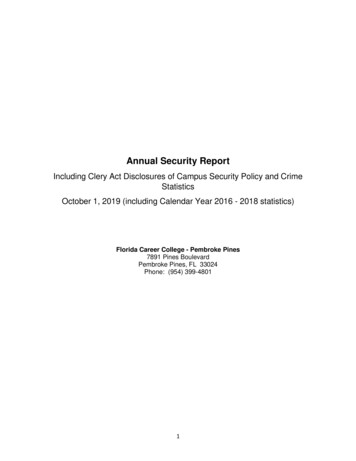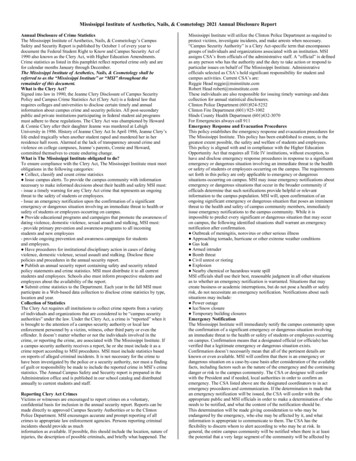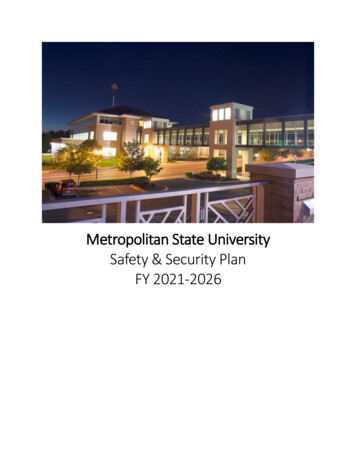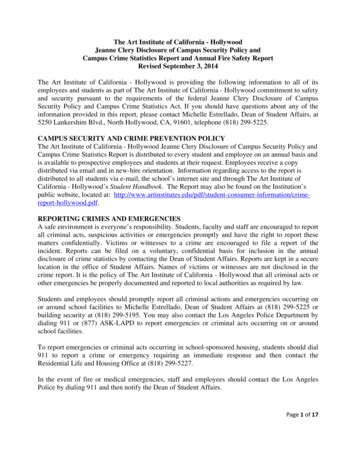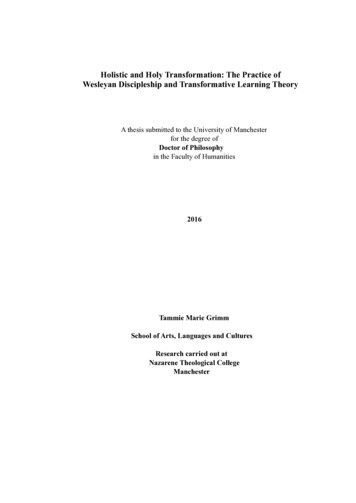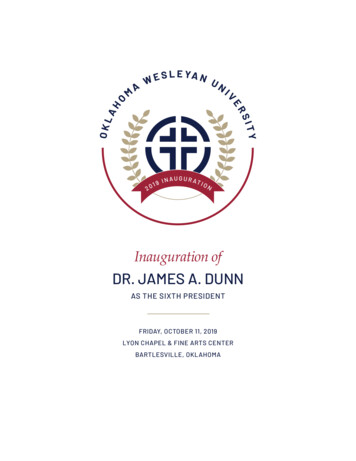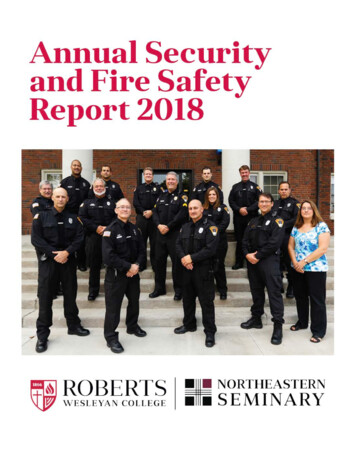
Transcription
In 1986, Jeanne Clery was a student at Lehigh University who was murdered in her dorm room byanother student. Clery’s parents, who believed the University had failed to share vital information withits students regarding campus safety, campaigned for legislative reform for several years following theirdaughter’s death. Their sustained efforts resulted in the passage of the Clery Act, a federal law requiringall universities and colleges receiving federal student financial aid to report crime statistics, alert thecampus community of imminent dangers, and distribute an Annual Security and Fire Safety Report tocurrent and prospective students and employees.Table of ContentsWe urge members of the Roberts Wesleyan College and Northeastern Seminary Campus (referred to inthis report as the “College”) community to use this report as a guide for safe practices on and offcampus. The College sends an e-mail to every enrolled student and current employee on an annual basisto notify that the report is available to be viewed. The e-mail includes a brief summary of the contentsof this report and the web address for the Roberts Wesleyan College website where the Annual Securityand Fire Safety Report can be found. The report is available online at afety/resources.aspx. You may request to have a hard copy mailed to you bycalling 585-594-7777. The hard copy shall be mailed within ten days of the initial request (NYS EducationLaw 129A section 6433). A copy of the report can also be obtained from the RWC Campus Safety officelocated in Room 270, Voller Athletic Center, Roberts Wesleyan College, 2301 Westside Drive, Rochester,New York, 14624.Department of Campus Safety . .3Reporting Procedures . . 4Emergency Notifications, Response and Evacuation Procedures . . . .5Timely Warnings . . 7Campus Security and Access . 7Definition of Geography . .8Definition of Categories . . .8Unfounded Crimes . 14Hate Crimes . . 14Crime Statistics . 14Crime Prevention/ Safety Awareness . .15Alcohol and Drug Policies . . . 16Firearms and Weapons Policies . . 19Domestic Violence, Dating Violence, Sexual Assault and Stalking . . .19Sex Offender Registry .45Notification of Missing Students residing in On-Campus Housing .45Hate Crimes Reporting . . 46Unfounded Crimes Reporting . .46Criminal Offenses Reporting Table .46Arrests and Disciplinary Referrals Reporting Table . . .47VAWA Offenses Reporting Table . 47Annual Fire Safety Report . .48Prohibited Items and Activities . .50Fire Statistics . .511
Message from the Roberts Wesleyan College Campus Safety DepartmentDear Roberts Wesleyan College and Northeastern Seminary Community,The College is committed to providing a safe and secure environment for our students, faculty, staff andvisitors. To that end, we are pleased to present the Annual Security and Fire Safety Report.This report is prepared by the Campus Safety Department, which is responsible for ensuring the safetyand security of the College community from all hazards, including crime.This report will provide you with information on safety and security at the campus. Inside you will findinformation regarding policies and procedures for reporting crime, safety and security and protectionprograms, victim assistance services, fire safety and other material to assist you in maintaining yoursafety and security. This report is provided in compliance with the Jeanne Clery Disclosure of CampusSecurity Policy and Crime Statistics Act (Clery Act) and the Higher Education Opportunity Act (HEOA).We encourage you to read this information and consider how it can help you and the Collegecommunity to prevent and protect yourself against crime. Thank you for taking time to review thisinformation and helping to make Roberts Wesleyan College and Northeastern Seminary a safercommunity.Sincerely,Ruth LoganVice President for Student &Organizational DevelopmentRichard BillitierDirector of Campus SafetyRoberts Wesleyan College and Northeastern SeminaryLocated just outside of Rochester, New York- one of America’s most livable cities- Roberts WesleyanCollege is a vibrant private Christian College that offers excellence in liberal arts and professionalprograms.About Roberts Wesleyan CollegeRoberts Wesleyan College is committed to character development, Christ-centered education,transformational learning and service. With an enrollment of 1,708 students and a tradition ofexcellence for over 150 years, the College strives to inspire students to transform themselves and theworld, and offers 87 undergraduate, graduate and adult-degree completion programs taught by highquality, supportive faculty. The College also has a doctoral program in Clinical & SchoolPsychology. Redhawks Athletics offers 19 intercollegiate sports. Roberts Wesleyan was honored onthe 2015, 2016 and 2017 Great Colleges to Work For list, presented by The Chronicle of HigherEducation.2
About Northeastern SeminarySince opening its doors in 1998, Northeastern Seminary on the campus of Roberts Wesleyan College hascontinued to grow in prominence as a significant resource for the church community in upstate NewYork. Northeastern Seminary is a multi-denominational graduate school of theology offering fiveacademically and professionally accredited degrees: Master of Divinity, Master of Arts of TheologicalStudies, Master of Arts in Theology and Social Justice, Master of Arts in Transformational leadership, andDoctor of Ministry. The student body is comprised of more than 30 different faith traditions representedamong 130 students and 500 graduates ministering around the nation and world.Department of Campus SafetyMissionRoberts Wesleyan College Campus Safety will provide for a safe environment conducive to theeducational process for the College students, faculty, staff, and visitors; and will provide a positiveenvironment where all College community members may participate in the transformational experiencewhile utilizing their talents, respecting one another, and growing as individuals.Department of Campus SafetyThe Vice President for Student & Organizational Development is responsible for the Department ofCampus Safety. The College’s Department of Campus Safety is organized and staffed to provide essentialservices and to respond to critical situations on the main campus twenty four hours a day, seven days aweek.The Department is led by the Director and includes an Assistant Director, 22 full and part time CampusSafety Officers as well as a Student Patrol Division.Campus Safety is not a sworn law enforcement agency. Campus Safety Officers have the authority to askpersons for identification and to determine whether individuals have lawful business on Collegeproperty. Campus Safety is charged with the enforcement of public conduct standards on campus.Campus Safety Officers have the authority to eject and ban violators from College/Seminary property.Campus Safety Officers have the authority to issue parking tickets, which are billed to financial accountsof students, faculty and staff.Working RelationshipsCampus Safety maintains a highly professional working relationship with the Monroe County Sheriff’sOffice, the Town of Ogden Police Department and the New York State Police. Campus Safety worksclosely with these agencies when incidents arise that may require joint investigative efforts, resources,crime related reports and exchanges of information. The College has also entered into a Memorandumof Understanding with the Monroe County Sheriff’s Office regarding the duties and obligationsconcerning the coordination of law enforcement efforts between the College and the Monroe CountySheriff’s Office for the investigation of alleged criminal offenses. Campus Safety maintains a closeworking relationship with the liaison from the New York State Police Campus Sexual Assault VictimsUnit.3
TrainingCampus Safety Officers meet the training requirements prescribed by New York State for SecurityGuards. In addition to this training, officers are required to attend CPR, AED, and Basic First Aidcertification. A majority of our Campus Safety Officers are current and retired law enforcementprofessionals.Reporting ProceduresProcedures for students or others to report criminal actions or other emergencies occurring oncampus.The College encourages the accurate and prompt reporting of all crimes or other emergencies toCampus Safety and the appropriate police agencies, when the victim of a crime elects to, or is unable to,make such a report. By working together, the campus community and Campus Safety can reduce crimeon campus. Reporting can also ensure the prompt issuance of Timely Warnings and the accuratecollection of crime statistics for the annual statistical disclosure. Members of the campus communitymay report criminal activities or other emergencies in several different ways. While we encourage allcampus community members to promptly report all crimes and other emergencies directly to CampusSafety, we recognize that some may prefer to report to other individuals or campus offices. Studentsand employees may report criminal offenses to:Campus Safety, Voller Athletic Center Room 270, 585.594.7777Monika Robertson, Title IX Coordinator, lower Rinker, robertson monika@roberts.eduJennifer Aube, Harassment Officer, Carpenter Hall, aube jennifer@roberts.eduJohn Walker, Harassment Officer, Chesbro Center, walker@roberts.eduMike Broberg, Dean of Students, lower Rinker, brobergm@roberts.eduRuth Logan, VP for Student & Organizational Development, lower Rinker, logan ruth@roberts.eduReporting to Local Law EnforcementA person reporting a crime to Campus Safety has the right to report the crime to local law enforcementby calling 911. Campus Safety Officer’s regularly offer this option with the victim of a crime and willassist the victim with that process. A victim/reporting persons request for contacting law enforcementwill not be denied.Voluntary Confidential Crime ReportingIf you are the victim of a crime and do not want to pursue action within the College system or thecriminal justice system, you may want to consider making a voluntary confidential report. A CampusSafety Officer can file a report on the details of the incident without revealing the victim’s identity. Thepurpose of a voluntary confidential report is to maintain confidentiality, while taking steps to ensure thefuture safety of yourself and others. With such information, the College can keep an accurate record ofthe number of incidents involving students, employees and visitors; determine where there is a patternof crime with regard to a particular location, method, or assailant, and alert the campus community to4
potential dangers. Reports filed in this manner are counted and disclosed in the annual crime statisticsfor the institution, and when they involve allegations of domestic violence, dating violence, sexualassault and stalking are made available to the College’s Title IX Coordinator.Emergency Blue Light Phones12 emergency blue light phones are located on the RWC/NES campus. Once activated, these phones willput you in direct contact with a Campus Safety Officer.Emergency Notifications, Response and Evacuation ProceduresYour safety is important to us. We want to be able to inform you of campus emergencies. All students,faculty and staff are encouraged to sign up for “Roberts Alert” each semester. To register for campusemergency notifications, register your cell number on the Emergency Contacts page athttp://www.roberts.edu/ go to the RWC Intranet, click on “Students” then “Emergency Contacts”.Follow the texting instructions and fill in the emergency contact information. This will keep youinformed of any emergency on the main campus. During any emergency situation which requiresnotifications on campus, you will receive an urgent Security message from 585-594-6000.If you become aware of an emergency on campus, immediately contact Campus Safety at 585-594-7777.The College has procedures in place that will be used to immediately notify the campus communityupon the confirmation of a significant emergency or dangerous situation involving an immediate threatto the health or safety of students or employees occurring on campus.Campus Safety officers are on duty twenty four hours a day, seven days a week, including holidays.Campus Safety will be the first to respond to any significant emergency or dangerous situation oncampus. Depending on the severity of the situation, the Director of Campus Safety would be notifiedimmediately (if the Director is unavailable, the responsibility would fall to the highest ranking supervisoravailable as established by the Campus Safety Chain of Command). The Director (or highest rankingsupervisor) will make contact with the Vice President for Student and Organizational Development (or)the Dean of Students.Upon confirmation of a significant emergency or dangerous situation, outside resources may be calledupon for assistance. The College partners with two local police agencies (Monroe County Sheriff’s Officeand Ogden Police Department) for any criminal, health or safety issues exceeding the limitations of aCampus Safety officer. The College also partners with two fire agencies (Chili and Spencerport FireDepartments) for situations requiring their assistance. The location of the facility on campus wouldmandate which fire service and police agency respondsThe Roberts Wesleyan College Emergency Response Team (ERT) may also be contacted to respond.Should outside police or fire authorities be summoned to campus, Campus Safety will work to assistthese agencies. The ERT will stay in communication with Campus Safety and these authorities and keepstudents and staff updated regarding the situation.5
The Vice President for Student and Organizational Development (or) the Dean of Students, working withthe Director of Campus Safety, will determine whether to initiate the notification system, the content ofthe notification and to what segment of the campus population should be notified. Depending on thesituation, a small segment of the campus community may be notified (for example, an incident thatinvolves only students residing on campus) or the entire campus community may be notified when thereis at least the potential that a very large segment of the community will be affected by the situation orwhen a situation threatens the operation of the campus as a whole.Regardless of the situation, the College will, without delay, and taking into account the safety of thecommunity, determine the content of the notification and initiate the notification system, unless issuinga notification will, in the professional judgment of responsible authorities, compromise the efforts toassist a victim or to contain, respond or otherwise mitigate the emergency.The options for mass notification instituted around campus are the Roberts Alert system using thephone numbers that individuals have voluntarily signed up for. A campus wide E-mail distribution listhas also been set up to notify students and staff of situations while also giving them any neededdirections. This communication would have some delay for actual contact. Campus Safety also utilizes anEmergency Alert Air Horn. The air horn will be used to advise the campus community that the campus isgoing into lockout/lockdown. The air horn may be used to advise of other impending emergencies (i.e.;weather related) only if preceded by a Roberts Alert.The College may also utilize local media to assist with notifications. Procedures are in place to notifylocal television and radio stations of any emergency announcements.Lockdown/ lockout drills are conducted annually. Prior to the drill, at least (2) emails are sent to allfaculty and staff publicizing the drill and specific procedures faculty and staff should take. A drillinvolving the ERT is also conducted at least annually. These drills may consist of table top exercisesand/or real time events. A debriefing meeting with ERT members is scheduled after the drill to discussthe event.Each semester Campus Safety performs two (2) fire drills in each dorm. One drill is done in the eveningand one at night. Campus Safety also performs one (1) fire drill each semester and one (1) during thesummer at each academic building on campus. Fire drills are timed and all occupants are expected toparticipate and evacuate. No prior notification is given as to the timing of these drills. The purpose ofthese drills is to familiarize occupants with evacuation procedures, the sound of the alarms, and thelocations of all exits in an area. At the beginning of the fall semester, Campus Safety instructs ResidenceStaff and building residents on floor and fire exit evacuation, how to report a fire alarm activation intheir residence halls and awareness of the unannounced drills.Campus Safety conducts an annual test of the Emergency Alert Air Horn. Students and staff are notifiedin advance via email. Letters are sent to community members residing in the vicinity of the campusspecifying the time, date and duration of the test. Local municipalities as well as local law enforcementagencies are advised as well.Documentation is kept for each drill as well as a description of the exercise, the date, time and whetherit was announced or unannounced.6
In the event a building evacuation becomes necessary, Campus Safety Officers will direct all occupantsto the closest available stairway or exit, while keeping them calm and orderly. Elevators will not be used.When evacuating, all interiors will be checked. During the incident, after the building is clear, CampusSafety officers will ensure that no one re-enters the building except emergency crews. If inclementweather conditions exist, arrangements shall be made to move the evacuated persons to an alternatesite away from the potential danger zone that will provide shelter while the event is being addressed.Procedural guidelines for a campus wide evacuation are outlined in the Roberts Wesleyan College andNortheastern Seminary Emergency Response Plan. Memorandums of Understanding are in place with alocal school district to be used as an alternate site if necessary.Timely WarningsTimely Warnings are required to be issued for all Clery Act crimes that occur on the College’s Clery Actgeography that are reported to Campus Security Authorities or local law enforcement and considered bythe College to represent a serious or continuing threat to students and employees.Students, faculty, staff, community members and guests are encouraged to report all crimes and publicsafety-related incidents to Campus Safety in a timely manner to aid in providing accurate and timelywarning notices to the community when appropriate, and to ensure inclusion in the annual crimestatistics. In the event of a serious incident which may pose an on-going threat to members of theCollege community, a Timely Warning in the form of a Security Alert is sent to all affected students andemployees on campus. The alerts are generally written and distributed to the campus community by theDirector of Campus Safety or the Vice President for Student Organization & Development.Alerts and updates to the College community about any particular case may be distributed via blastemail or text message, and posted on the Roberts Wesleyan College website. Security Alert posters mayalso be posted by Campus Safety in campus buildings when deemed necessary. When Security Alerts areposted in campus buildings, they are posted in the lobby/entrance area of affected building(s) for atleast seven days.The issuance of a Timely Warning will be decided on a case by case basis. Factors to be taken intoconsideration are the nature of the crime, whether there is a continuing danger to the campuscommunity and the possible risk of compromising law enforcement efforts.Campus Security and AccessMain CampusDuring business hours, the College (excluding residence halls) will be open to students, parents,employees, contractors, guests and invitees. During non-business hours access to the College facilities isby key, if issued, or by swipe card. Contractors are required to sign in to the Campus Safety Office wherethey are issued temporary identification cards.7
Residence HallsResidence halls are secured 24 hours a day. Some residence halls are accessed by key only and others byswipe card only.Security MaintenanceFacilities and landscaping are maintained in a manner that minimizes hazardous conditions. CampusSafety regularly patrols the main campus and reports malfunctioning lights and other unsafe conditionsto facilities management for repair. Other members of the campus should promptly report maintenanceproblems to Campus Safety or Facilities Management.Definition of GeographyOn-Campus: Any building or property owned or controlled by an institution within the same reasonablycontiguous geographic area and used by the institution in direct support of, or in a manner related to,the institution’s educational purposes, including residence halls; andAny building or property that is owned by the institution but controlled by another person, is frequentlyused by students, and supports institutional purposes.Public Property: All public property, including thoroughfares, streets, sidewalks, and parking facilitiesthat is within the campus or immediate adjacent to and accessible from the campus.Non-Campus Building or Property: Any building or property owned or controlled by a studentorganization that is officially recognized by the institution; orAny building or property owned or controlled by an institution that is used in direct support of, or inrelation to the institution’s educational purposes, is frequently used by students, and is not within thesame reasonably contiguous geographic area of the institution.Definition of CategoriesDefinitions from the Summary Reporting System (SRS) User Manual from the Federal Bureau ofInvestigation’s Uniform Crime Reporting ProgramMurder and Nonnegligent Manslaughter: The willful (nonnegligent) killing of one human being byanother.Manslaughter by Negligence: The killing of another person through gross negligence.Robbery: The taking or attempting to take anything of value from the care, custody, or control of aperson or persons by force or threat of force or violence and/or by putting the victim in fear.Aggravated Assault: An unlawful attack by one person upon another for the purpose of inflicting severeor aggravated bodily injury. This type of assault usually is accompanied by the use of a weapon or bymeans likely to produce death or great bodily harm.8
Burglary: The unlawful entry of a structure to commit a felony or theft.Motor Vehicle Theft: The theft or attempted theft of a motor vehicle.Arson: Any willful or malicious burning or attempt to burn, with or without intent to defraud, a dwellinghouse, public building, motor vehicle or aircraft and personal property of another, etc.Weapons: Carrying, Possessing, Etc.: The violation of laws or ordinances prohibiting the manufacture,sale, purchase, transportation, possession, concealment, or use of firearms, cutting instruments,explosives, incendiary devices or other deadly weapons.Drug Abuse Violations: The violation of laws prohibiting the production, distribution and/or use ofcertain controlled substances and the equipment or devices utilized in their preparation and/or use. Theunlawful cultivation, manufacture, distribution, sale, purchase, use, possession, transportation orimportation of any controlled drug or narcotic substance. Arrests for violations of state and local laws,specifically those relating to the unlawful possession, sale, use, growing, manufacturing and making ofnarcotic drugs.Liquor Law Violations: The violation of State or local laws or ordinances prohibiting the manufacture,sale, purchase, transportation, possession or use of alcoholic beverages, not including driving under theinfluence and drunkenness.Definitions from the Federal Bureau of Investigation’s National Incident-Based Reporting System(NIBRS) Data Collection Guidelines Edition of the Uniform Crime Reporting ProgramSex Assault (Offenses): Any sexual act directed against another person, without the consent of thevictim, including instances where the victim is incapable of giving consent.Rape: The penetration, no matter how slight, of the vagina or anus with any body part or object, or oralpenetration by a sex organ of another person, without the consent of the victim. This offense includesthe rape of both males and females.Fondling: The touching of private body parts of another person for the purpose of sexual gratification,without the consent of the victim, including instances where the victim is incapable of giving consentbecause of his/her age or because of his/her temporary or permanent mental incapacity.Incest: Sexual intercourse between persons who are related to each other within the degrees whereinmarriage is prohibited by law.Statutory Rape: Sexual intercourse with a person who is under the statutory age of consent.9
Definitions from the Federal Bureau of Investigation’s Uniform Crime Reporting Hate Crime DataCollection Guidelines and Training ManualLarceny-Theft: The unlawful taking, carrying, leading, or riding away of property from the possession orconstructive possession of another. Constructive possession is the condition in which a person does nothave physical custody or possession, but is in a position to exercise dominion or control over a thing.Simple Assault: An unlawful physical attack by one person upon another where neither the offenderdisplays a weapon, nor the victim suffers obvious severe or aggravated bodily injury involving apparentbroken bones, loss of teeth, possible internal injury, severe laceration, or loss of consciousness.Intimidation: To unlawfully place another person in reasonable fear of bodily harm through the use ofthreatening words and/or other conduct, but without displaying a weapon or subjecting the victim toactual physical attack.Destruction/ Damage/ Vandalism of Property: To willfully and maliciously destroy, damage, deface, orotherwise injure real or personal property without the consent of the owner or the person havingcustody or control of it.Definitions of Domestic Violence, Dating Violence, and Stalking from the Violence Against WomenReauthorization Act of 2013 (VAWA).Domestic Violence: A felony or misdemeanor crime of violence committed By a current or former spouse or intimate partner of the victim;By a person with whom the victim shares a child in common;By a person who is cohabiting with, or has cohabited with, the victim as a spouse or intimatepartner;By a person similarly situated to a spouse of the victim under the domestic or family violencelaws of the jurisdiction in which the crime of violence occurred; orBy any other person against an adult or youth victim who is protected from that person’s actsunder the domestic or family violence laws of the jurisdiction in which the crime of violenceoccurred.For the purposes of complying with the requirements of this section and sub section 668.41, anyincident meeting this definition is considered a crime for the purposes of Clery Act reporting.Dating Violence: Violence committed by a person who is or has been in a social relationship of aromantic or intimate nature with the victim. The existence of such a relationship shall be determinedbased on the reporting party’s statement and with consideration of the length of the relationship, thetype of relationship, and the frequency of interaction between the persons involved in the relationship.For the purposes of this definition Dating violence includes, but is not limited to, sexual or physical abuse or the threat of suchabuse.Dating violence does not include acts covered under the definition of domestic violence.10
For the purposes of complying with the requirements of this section and sub section 668.41, anyincident meeting this definition is considered a crime for the purposes of Clery Act reporting.Stalking: Engaging in a course of conduct directed at a specific person that would cause a reasonableperson to Fear for the person’s safety or the safety of others; Suffer substantial emotional distress.For the purposes of this definition Course of conduct means two or more acts, including but not limited to, acts in which thestalker directly, indirectly or through third parties, by any action, method, device, or meansfollows, monitors, observes, surveils, threatens, or communicates to or about, a person, orinterferes with a person’s property.Reasonable person means a reasonable person under similar circumstances and with similaridentities to the victim.Substantial emotional distress means significant mental suffering or anguish that may, but doesnot necessarily, require medical or other professional treatment or counseling.For the purposes of complying with the requirements of this section and sub section 668.41, anyincident meeting this definition is considere
Roberts Wesleyan College and Northeastern Seminary Located just outside of Rochester, New York- one of America's most livable cities- Roberts Wesleyan College is a vibrant private Christian College that offers excellence in liberal arts and professional programs. About Roberts Wesleyan College
